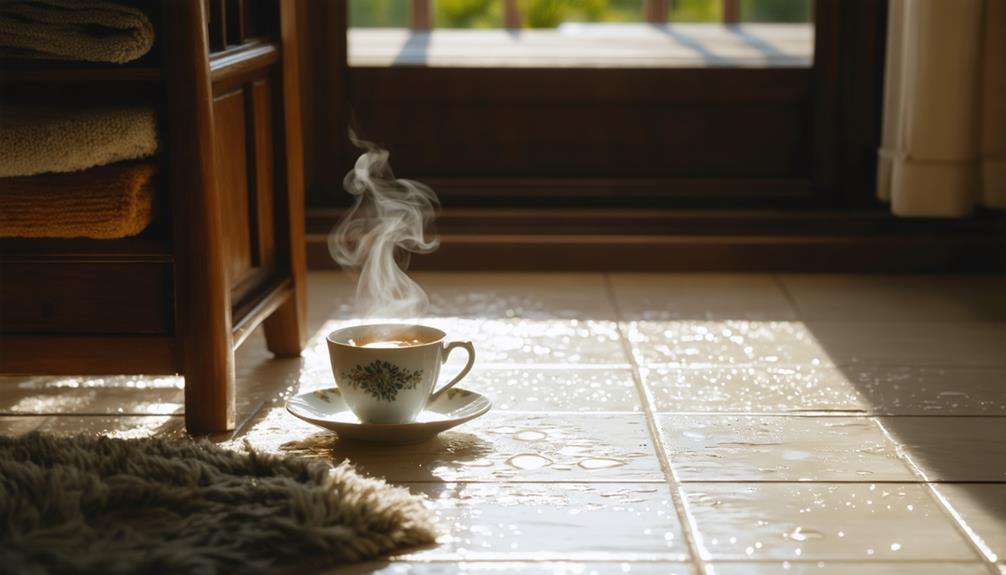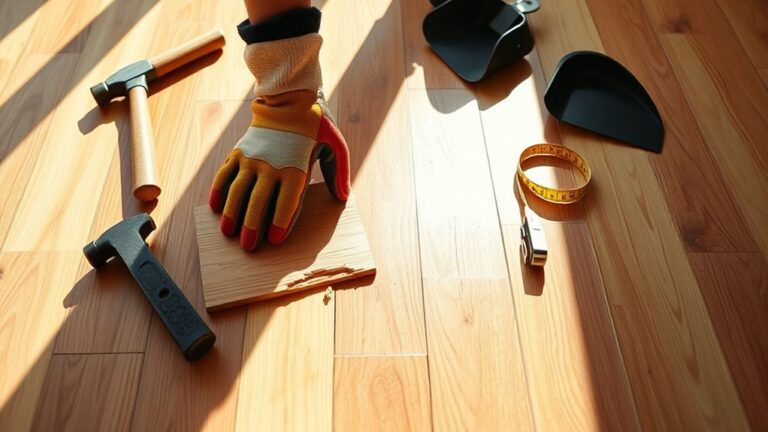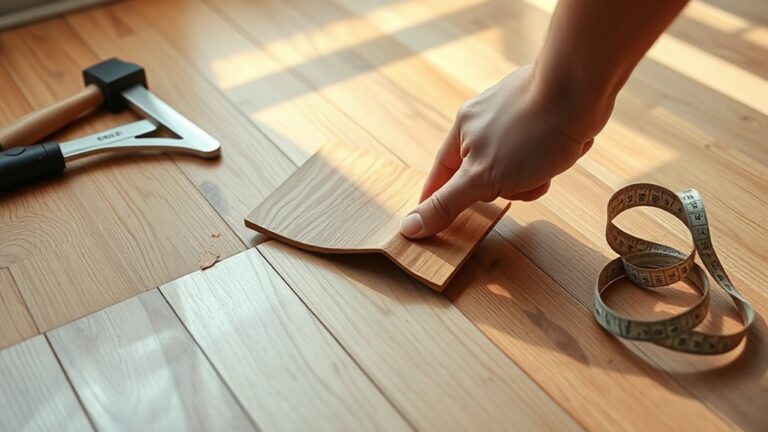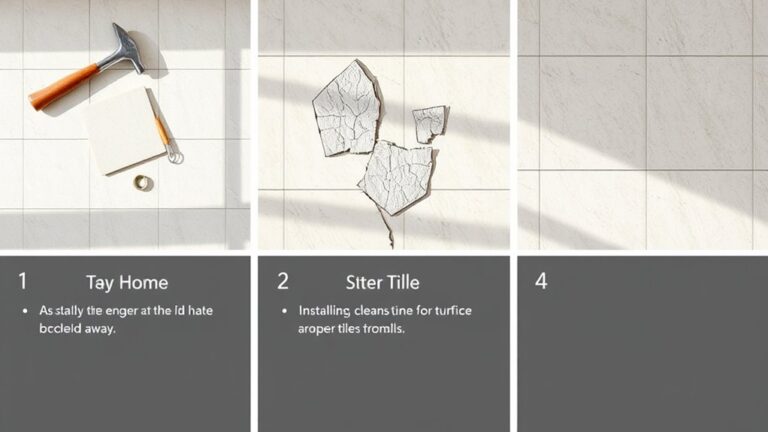Dealing with condensation on cold floors requires understanding the causes, mainly the interplay of warm, humid air meeting cooler surfaces. Insufficient insulation and poor airflow exacerbate this issue, leading to slippery floors and potential mold growth. To combat condensation, improve air circulation with fans, maintain humidity levels between 30-50% using dehumidifiers, and install vapor barriers to block moisture. Regular monitoring and maintenance of HVAC systems also play critical roles in prevention. By implementing these strategies, you can mitigate risks and protect your property from ongoing moisture issues. Explore additional techniques to enhance your indoor climate control further.
Understanding Concrete Sweating
When warm, humid air comes into contact with cooler concrete surfaces, you might notice a phenomenon known as concrete sweating. This occurs when the temperature of the concrete slab falls below the dew point of the surrounding air, leading to condensation on the surface. The process is particularly prevalent in environments where warm, moist air coexists with cooler concrete floors, such as during humid nights.
Understanding concrete sweating is significant, especially if you want to maintain a safe and comfortable environment. Several factors can exacerbate this issue, including significant temperature swings, high humidity levels, poor insulation, and inadequate air circulation. Each of these elements contributes to the likelihood of condensation forming on your floors.
Concrete sweating isn't just an aesthetic problem; it can create serious safety hazards. Slippery surfaces can lead to accidents, while persistent moisture can promote mold growth, damaging both flooring materials and indoor air quality. If left unaddressed, you might also face increased maintenance costs due to the deterioration of your flooring and potential structural issues.
To mitigate the risks associated with concrete sweating, it's important to monitor indoor humidity levels, improve insulation, and enhance air circulation within your space. By taking proactive measures, you can create a more comfortable and safe living or working environment while preserving the integrity of your flooring and structure.
Causes of Sweating Floors
Sweating floors happen mainly due to significant temperature differences between warm air and cold concrete surfaces. High humidity levels further exacerbate this issue, allowing moisture to condense on the floor. Additionally, inadequate insulation and poor airflow can contribute to an environment where sweating becomes prevalent.
Temperature Differences Impacting Condensation
Condensation on cold floors is primarily driven by temperature differences between the ambient air and the concrete surface. When warm, humid air comes into contact with cooler concrete, the temperature of the surface may fall below the dew point of the surrounding air, resulting in moisture accumulation. This phenomenon is particularly prevalent during humid nights when the temperature drops, causing increased condensation risk.
If the temperature of your concrete slab is considerably lower than that of the room, condensation is likely to form. Poor insulation can worsen this issue, as it creates a greater temperature differential, allowing cooler air to linger near the floor. Additionally, inadequate air circulation contributes to the problem; without proper airflow, the warm, humid air remains trapped near the floor, intensifying sweating.
To mitigate condensation, it is crucial to monitor and manage the temperature of both the air and the concrete surfaces. By ensuring adequate insulation and improving air circulation, you can minimize the chances of condensation forming on your floors, maintaining a more comfortable and moisture-free environment.
Humidity Levels and Effects
Humidity levels play a critical role in the formation of sweating floors, especially in environments where warm air interacts with cooler concrete surfaces. When humidity exceeds 60%, the likelihood of condensation on your cold floors increases greatly. This happens because the warm, moist air comes in contact with the cooler floor temperature, leading to moisture accumulation that can create slippery conditions.
Temperature swings also exacerbate this issue. For instance, if the air temperature rises while the concrete remains cool, condensation can occur when the air cools down again. Over time, this moisture can lead to efflorescence, resulting in unsightly white patches on your concrete surfaces.
To combat these humidity-related challenges, consider implementing moisture barriers and improving air circulation in your space. These strategies can effectively reduce humidity levels and prevent the occurrence of sweating floors. By maintaining a balance in humidity and floor temperature, you can create a more comfortable and safer environment in your home or workspace. Understanding these dynamics is essential for addressing condensation issues and protecting your flooring investment.
Insulation and Airflow Issues
When it comes to maintaining comfortable indoor conditions, inadequate insulation and poor airflow can markedly contribute to the problem of sweating floors. When warm, humid air comes into contact with a cold floor slab, condensation occurs, leading to moisture accumulation. If your insulation isn't sufficient, you may experience significant temperature differentials between the indoor air and the cold concrete. This increases the likelihood of condensation, particularly in spaces like basements or unconditioned areas.
Moreover, poor airflow can trap humid air near the floor, exacerbating sweating issues. In high-occupancy areas or during activities that generate heat, the combination of warm air and cold surfaces creates an ideal environment for condensation. To combat this, it's essential to improve airflow management. Utilizing fans or implementing effective ventilation systems can help circulate air and reduce humidity levels near the floor slab, mitigating the sweating issue.
Investing in proper insulation not only helps maintain consistent temperatures but also minimizes the risk of condensation forming on your cold floors. By addressing these insulation and airflow issues, you can create a more comfortable and moisture-free environment in your space.
Problems Associated With Condensation
Condensation on cold floors presents significant safety hazards, as slippery surfaces can lead to falls and injuries, especially in busy areas. Additionally, the moisture creates an ideal environment for mold growth, which poses health risks and can necessitate expensive remediation. Addressing these issues is essential to maintaining both safety and indoor air quality.
Safety Hazards of Slippery Floors
Slippery floors created by excess moisture can pose serious safety hazards, especially in busy environments. When condensation forms, it increases the risk of slips and falls, leading to potential injuries. In fact, studies show that nearly 25% of slip-and-fall incidents occur on wet or slippery floors in workplaces. You must recognize these dangers to maintain a safe environment.
| Risk Factor | Impact | Prevention Strategy |
|---|---|---|
| Slips and Falls | Serious injuries | Regular cleaning and drying |
| Legal Liability | Lawsuits and compensation claims | Implementing safety protocols |
| Equipment Damage | Increased maintenance costs | Use moisture barriers |
| Employee Morale | Decreased productivity | Improve workplace safety culture |
| Aesthetic Appeal | Uninviting environments | Regular inspections and maintenance |
Long-term moisture exposure can not only harm flooring materials but also create an unprofessional atmosphere. By addressing the issues associated with slippery floors, you can enhance safety and maintain an inviting space. Remember that proactive measures are key to preventing accidents and preserving both the integrity of your floors and the well-being of those in your environment.
Mold Growth Risks
Mold growth poses significant risks in environments where moisture is prevalent, especially on cold floors. When condensation accumulates on surfaces like a concrete floor, it creates an ideal setting for mold to thrive. Within just 24-48 hours of water exposure, mold can begin to develop, rapidly spreading if the underlying moisture issue isn't addressed.
The consequences can be severe: structural damage may occur, leading to costly remediation efforts. Additionally, exposure to mold spores can result in serious health problems, particularly for sensitive individuals, causing respiratory issues, allergies, and asthma.
Aesthetically, dark, damp areas often harbor unsightly mold patches, diminishing your property's value and appeal. Moreover, mold growth can produce musty odors that render indoor spaces uncomfortable and unwelcoming.
To safeguard your health and property, it's vital to tackle condensation on cold floors proactively. Investing in proper insulation, ventilation, and dehumidification can mitigate these risks effectively, ensuring your environment remains mold-free and pleasant. By taking these steps, you can enjoy the freedom of a safe, comfortable living space while protecting your investment.
Prevention Techniques for Cold Floors
If you're dealing with cold floors, implementing effective prevention techniques can greatly reduce the risk of condensation. By addressing the underlying factors contributing to condensation, you can create a more comfortable and moisture-controlled environment. Here are some essential strategies to take into account:
- Enhance Air Circulation: Utilize high volume low speed fans to promote airflow, minimizing stagnant humid air near cold floors. This reduces the likelihood of moisture accumulation.
- Maintain Consistent Temperature: Adjust indoor temperature settings to minimize the temperature differential between warm air and cold floors. This balance helps in reducing condensation risk.
- Control Humidity Levels: Employ dehumidifiers to effectively lower indoor humidity levels. High humidity is a primary contributor to condensation on cold surfaces, so keeping it in check is vital.
Additionally, applying penetrating sealers and densifiers to concrete surfaces can create a moisture barrier, preventing moisture ingress and subsequent condensation on cold floors. Regularly monitor humidity levels and make necessary adjustments to your ventilation and temperature control systems to maintain ideal conditions.
Effective Remedies and Solutions
Implementing prevention techniques lays a solid foundation for addressing condensation issues on cold floors. To effectively combat this problem, consider installing large dehumidifiers in your cold rooms. These units can greatly reduce humidity levels, therefore minimizing condensation on your concrete slab. Additionally, using vapor barriers during construction is vital; they prevent moisture from penetrating from below, thereby reducing the risks associated with condensation.
Air circulation is another essential factor. By utilizing high volume low speed fans, you can enhance air movement, maintaining a consistent temperature across the floor surface. This helps mitigate the formation of condensation. Regularly monitoring and adjusting room temperatures is equally important. Keeping the environment above the dew point will lower the likelihood of condensation accumulating on cold floors.
Furthermore, implementing radiant heating systems is an effective way to maintain warmer floor temperatures. This approach helps eliminate the temperature differential that often contributes to condensation on your concrete slab. By ensuring that the flooring remains at a comfortable temperature, you can greatly reduce moisture buildup.
Maintenance and Long-term Strategies
Maintaining a healthy indoor environment is vital for preventing condensation on cold floors over the long term. To achieve this, you need to adopt specific maintenance strategies that focus on humidity control, insulation integrity, and HVAC functionality. By doing so, you can create a comfortable space free from the risks associated with condensation.
Here are three important strategies you should implement:
- Monitor Humidity Levels: Regularly check indoor humidity and maintain it between 30-50%. This range greatly minimizes the likelihood of condensation forming on your floors.
- Seal Gaps and Leaks: Conduct routine inspections to identify and seal any gaps in insulation, windows, and doors. This step prevents moisture from entering your space and keeps your indoor environment stable.
- Scheduled HVAC Maintenance: Implement a maintenance plan for your HVAC systems to guarantee they provide ideal airflow and humidity control. This will help regulate temperature and reduce moisture levels effectively.
In addition to these strategies, consider utilizing moisture-resistant materials in your flooring and insulation. This can greatly reduce the risk of damage from condensation over time. It's also wise to engage professionals for periodic assessments and repairs of your insulation and ventilation systems. By prioritizing these long-term strategies, you'll not only protect your floors but also enhance the overall air quality and comfort of your living space.
Frequently Asked Questions
How Do I Stop Condensation on My Floor?
To stop condensation on your floor, you should focus on humidity control. Start by using dehumidifiers to keep indoor humidity levels below 60%. Improve air circulation with fans to prevent stagnant air. Consider installing vapor barriers to block moisture from the ground and upgrade insulation in walls and floors to reduce temperature differences. Regularly monitor and adjust indoor temperatures, ensuring they remain above the dew point to minimize condensation risks.
How Do You Stop Condensation in a Cold House?
To stop condensation in a cold house, you need effective humidity control. Start by keeping your indoor temperatures consistently above the dew point, which prevents warm, moist air from hitting cold surfaces. Insulate your walls, ceilings, and floors to reduce temperature differences. Use dehumidifiers to lower indoor humidity levels, and improve ventilation by opening windows or using exhaust fans. Finally, seal leaks around windows and doors to maintain a stable environment.
Why Is My Floor Wet in My House in Winter?
If your floor's wet in winter, it's likely due to high humidity levels indoors. Warm air holds more moisture, and when it contacts cooler surfaces, like your floor, condensation forms. This is especially common if your home's insulation is inadequate or if there's insufficient air circulation. To address this issue, consider using a dehumidifier, improving insulation, and ensuring proper ventilation to maintain a comfortable and dry environment.
How Do I Stop Moisture From Coming up in My Concrete Floor?
To stop moisture from seeping silently into your concrete floor, install effective moisture barriers during construction. These barriers block unwanted water from beneath, creating a dry domain. Regularly inspect and seal any cracks to prevent pesky penetrations. Consider applying penetrating sealers, like Siloxa-Tek 8510, for added protection. Using a dehumidifier can also help by reducing overall humidity. Finally, conduct moisture tests to pinpoint the source of the problem, ensuring a moisture-free foundation.




